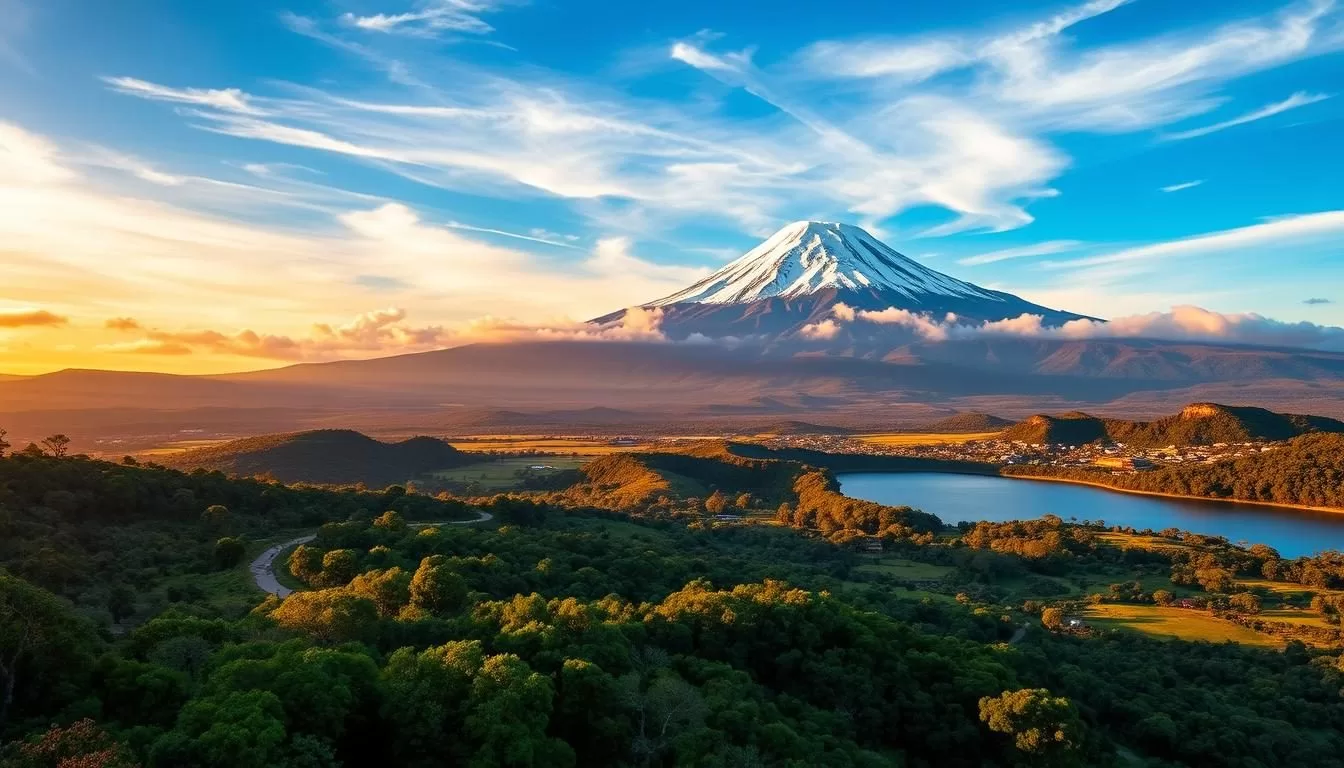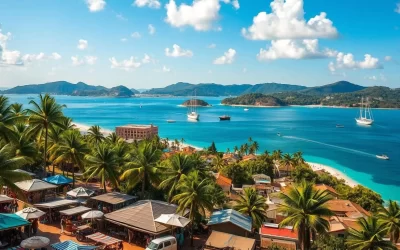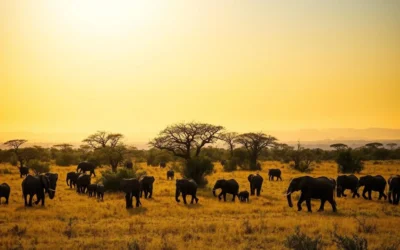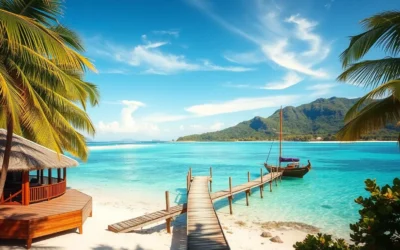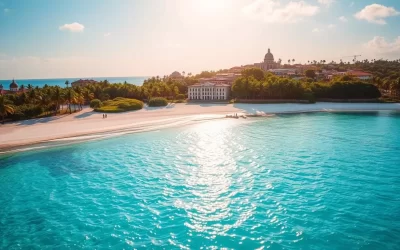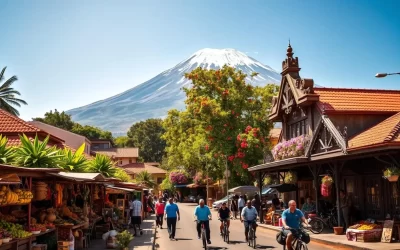✓ Accommodations✓ Flights✓ Rental Cars
Are you ready for an adventure of a lifetime? Located in northern Tanzania, near the town of Moshi, lies one of Africa’s most breathtaking destinations – Kilimanjaro National Park. As the third most visited national park in the country, it attracts thousands of visitors each year.
This national park is home to Africa’s highest peak and offers a variety of activities for adventure seekers and nature enthusiasts. Spanning approximately 1,688 square kilometers, the park was initially established as a game reserve in 1921 and later designated as a forest reserve in 1973.
With its unique position as a free-standing mountain, the park creates diverse climate zones and habitats, making it a biodiversity hotspot. Whether you’re planning to conquer the iconic mountain or explore its diverse ecosystems, this guide will help you plan your perfect adventure.
Discovering Mount Kilimanjaro National Park
Located in the heart of Tanzania, Mount Kilimanjaro National Park is a must-visit destination for nature lovers and adventure seekers alike. The park covers a total land area of 1,688 square kilometers, encompassing the montane forest belt above 1,820 meters above sea level.
Park Overview and Location
Mount Kilimanjaro National Park is one of Tanzania’s most visited national parks, after the Serengeti and Ngorongoro Crater. Declared a game reserve in 1921 and later designated as a forest reserve in 1973, the park is renowned for its diverse ecosystems and breathtaking landscapes. As you plan your trip to Kilimanjaro, understanding the park’s layout and location is crucial.
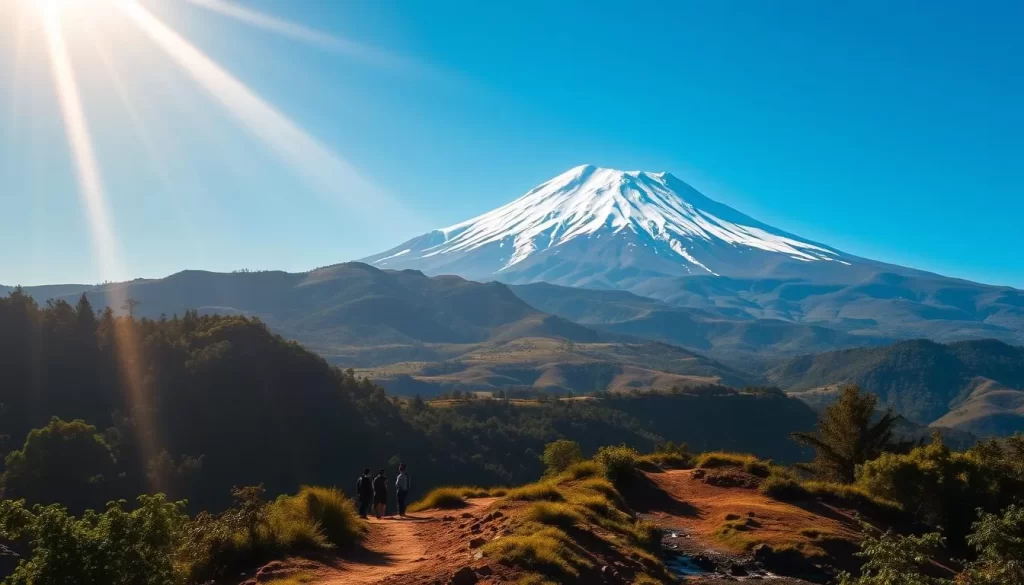
Best Time to Visit
The best time to visit Mount Kilimanjaro National Park is during the dry seasons, from January to mid-March and June to October, when weather conditions are most favorable for climbing Kilimanjaro and wildlife viewing. Here are some key considerations for planning your visit:
- January to mid-March and June to October are ideal for climbing due to dry conditions.
- December to February offers the clearest skies and best summit views, ideal for photography.
- Allocating 7-9 days for your trip allows for proper acclimatization, increasing your chances of reaching the summit.
- The park can be visited year-round, but the experience varies significantly with the season.
- Choosing a route that suits your experience and physical condition is vital for a successful climb.
- Visiting during full moon periods can provide spectacular nighttime views during your summit attempt.
By planning your visit at the right time and choosing the appropriate route, you can ensure a memorable and successful adventure at Mount Kilimanjaro National Park.
Climbing Mount Kilimanjaro: The Ultimate Adventure

Embarking on a journey to climb Mount Kilimanjaro is a significant undertaking that requires careful planning and preparation. As the highest peak in Africa, Mount Kilimanjaro, specifically Kibo Peak, offers a unique and exhilarating experience for climbers.
Popular Routes: Machame, Lemosho, and Marangu
The climb to the summit of Mount Kilimanjaro can be undertaken via several routes, each with its own characteristics. The Machame, Lemosho, and Marangu routes are among the most popular.
The Machame route, known for its scenic beauty, is a favorite among climbers. The Lemosho route offers a more gradual ascent, reducing the risk of altitude sickness. The Marangu route, often referred to as the “Coca-Cola” route, is considered one of the easier paths but is still challenging.
Preparation and What to Expect
Climbing Mount Kilimanjaro requires thorough preparation. Climbers should be prepared for varying weather conditions, from tropical to arctic, and challenging terrain.
The final ascent to the summit typically begins around midnight, with climbers facing steep switchbacks, scree, snow, and extreme cold. Understanding the challenges and being physically prepared is crucial.
Reaching Uhuru Peak: Africa’s Highest Point
Upon reaching Stella Point (5,756m), climbers continue to Uhuru Peak, the highest point in Africa at 5,895 meters (19,341 feet). The sense of achievement is immense, with panoramic views across Tanzania and into Kenya.
The experience at the summit is unforgettable, with the iconic wooden sign marking Uhuru Peak being a highlight for many climbers. Most climbers spend about 15-30 minutes at the summit before beginning their descent.
Exploring the Magnificent Shira Plateau
Exploring the Shira Plateau is a must-do adventure when visiting Kilimanjaro National Park, Tanzania. This vast, high-altitude plateau is a testament to the region’s unique geological history and ecological diversity.
The Ancient Volcanic Caldera
The Shira Plateau is essentially an ancient volcanic caldera, formed millions of years ago. This geological history has created a unique landscape that transitions from the montane forest below to the alpine desert above. The plateau’s high altitude and varied terrain support a range of ecosystems, making it a fascinating area for exploration. As you hike across the plateau, you are treated to spectacular views of Kibo’s glaciated summit and the plains of Kenya in the distance.
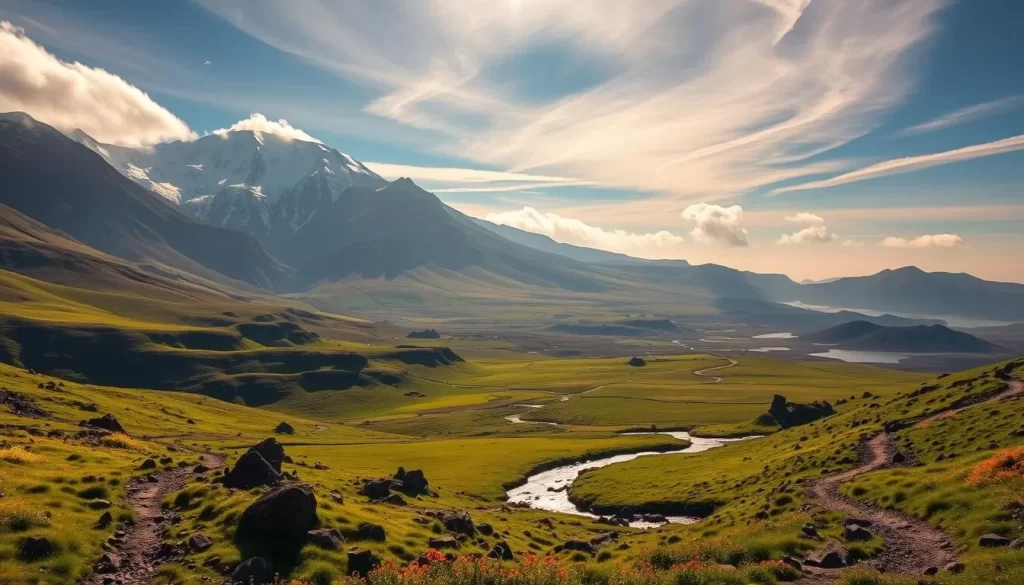
Flora and Fauna of the Plateau
The Shira Plateau is home to a variety of flora and fauna that have adapted to its harsh, high-altitude conditions. Giant groundsels and lobelias are among the unique plant species found here, creating an otherworldly landscape. Wildlife on the plateau includes adaptable species such as elands, buffalo, and occasionally elephants that venture up from the montane forest during certain seasons. The area is also a haven for game viewing and nature observation, with bird species like alpine chats and lammergeiers soaring above. As you enjoy hiking across the plateau, you’ll witness the remarkable adaptations of plants and animals to this extreme environment, all within the stunning Kilimanjaro National Park.
- The plateau hosts a unique ecosystem with specialized plants adapted to high-altitude conditions.
- Wildlife includes elands, buffalo, and occasional elephants.
- Bird species such as alpine chats and lammergeiers can be spotted.
Wildlife Viewing Opportunities in Mount Kilimanjaro National Park, Tanzania: Best Things to Do – Top Picks
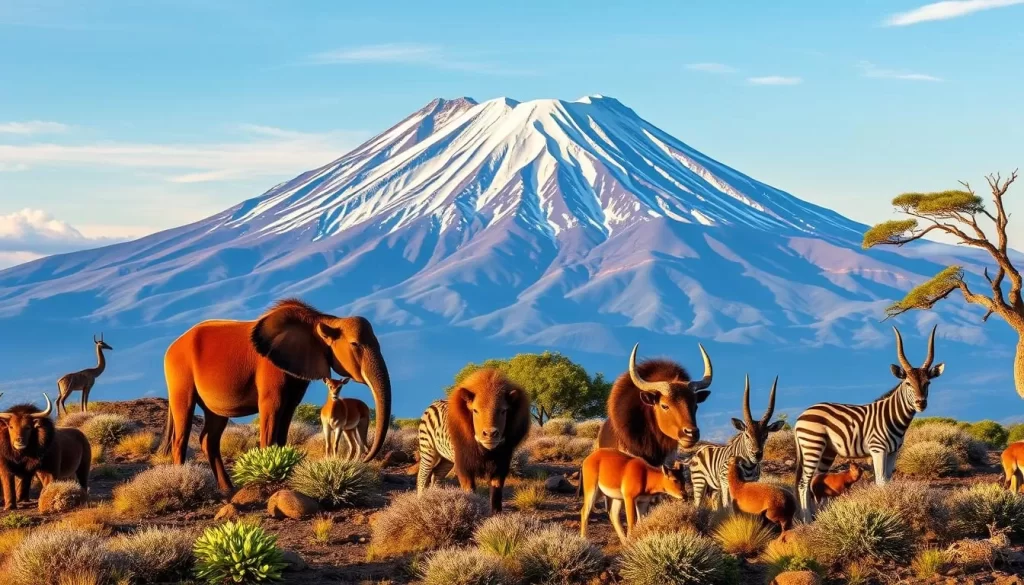
Wildlife enthusiasts will find Mount Kilimanjaro National Park a fascinating destination. The park is home to a wide range of wildlife, offering visitors numerous opportunities to observe animals in their natural habitats.
Forest Elephants and Other Large Mammals
The lower slopes of Mount Kilimanjaro are inhabited by forest elephants, buffaloes, and various antelope species. As you trek through the Kilimanjaro National Park, you may catch a glimpse of these large mammals. The park’s diverse habitats support a rich variety of wildlife, making it an exciting destination for visitors interested in activities like wildlife safaris.
During a day spent exploring the park, you can observe these animals in their natural environment. The presence of such a wide range of wildlife is one of the many reasons why Mount Kilimanjaro is a premier destination for nature lovers.
Bird Watching Paradise: 750+ Species
Mount Kilimanjaro is renowned for its incredible birdlife, with over 750 recorded species. The park offers a unique opportunity for bird enthusiasts to combine hiking with bird watching. As you ascend the mountain, you’ll pass through multiple vegetation zones, each supporting a distinct range of bird species.
The forest edge, particularly around 1,800-2,800 meters, is a hotspot for birding, with montane forest species mixing with those from lower elevations. Many visitors to the Kilimanjaro National Park take advantage of the opportunity to go on dedicated birding tours, led by expert guides who can identify species by sight and call. Whether you’re a seasoned birder or just looking to enjoy the activities available in the park, Mount Kilimanjaro is a must-visit destination.
Visit the Stunning Chala Crater Lake
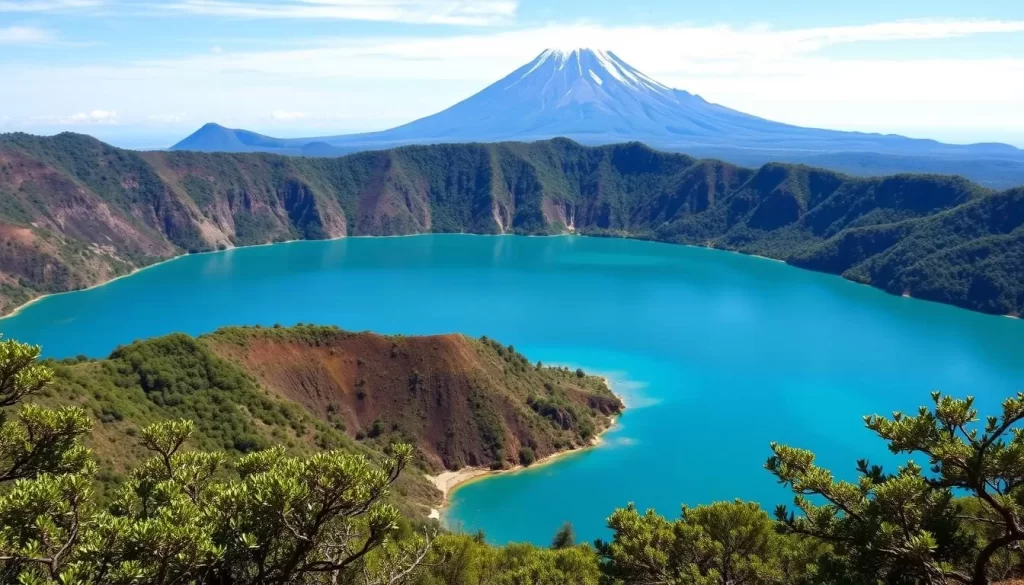
Chala Crater Lake, a hidden gem near Mt Kilimanjaro, is a spectacle of nature’s beauty. You can experience the serene atmosphere and breathtaking views that make this lake a must-visit destination.
The Color-Changing Waters
The Chala Crater lake’s waters are renowned for their mesmerizing color changes, ranging from turquoise to emerald green, depending on the time of day and weather conditions. You can witness this natural phenomenon and enjoy the scenic specular view of the crater lake.
The lake’s color-changing waters are not just a visual treat but also a reflection of the unique geology and ecology of the area. As you explore the surroundings, you’ll discover the fascinating reasons behind this phenomenon.
Activities Around the Lake
You can enjoy a variety of activities around Lake Chala, making your visit an unforgettable experience. Some of the popular activities include:
- Swimming in Lake Chala’s refreshing waters, providing a perfect natural swimming pool.
- Hiking trails around Lake Chala offer spectacular viewpoints of the crater and surrounding landscapes.
- Birdwatching enthusiasts will find Lake Chala a rewarding destination, with numerous species frequenting the crater area.
- Fishing for the endemic Lake Chala tilapia is permitted with proper arrangements, though conservation efforts restrict the activity.
- Photography opportunities abound at Chala Crater Lake, with the changing light creating different moods and colors.
- Camping facilities near Lake Chala allow you to experience sunset and sunrise over the crater.
- Guided tours of Lake Chala often include information about the local ecosystem, the lake’s formation, and its cultural significance.
As you explore the Chala Crater Lake, you’ll be immersed in the natural beauty and rich cultural heritage of the area. Make sure to plan your visit to this stunning destination and experience it for yourself.
Cultural Experiences Near Kilimanjaro
Beyond the majestic landscapes of Mount Kilimanjaro National Park, lies a wealth of cultural experiences waiting to be discovered. As you explore the region, you’ll have the opportunity to engage with the local communities and learn about their traditions.

Olpopongi Maasai Cultural Village
Olpopongi Maasai Cultural Village offers an authentic Maasai cultural experience. Here, you can learn about Maasai traditions, sample local cuisine, and gain a deeper understanding of their heritage. It’s a unique chance to see traditional Maasai homes and participate in cultural activities.
Local Traditions and Customs
The communities surrounding Mount Kilimanjaro, primarily the Chagga people, have developed unique traditions and customs. You can visit traditional Chagga homes and underground tunnels, showcasing ingenious construction techniques. Additionally, coffee tours on the lower slopes demonstrate the cultivation methods that have made Kilimanjaro coffee world-renowned. You can also witness local banana beer brewing demonstrations and cultural dances, showcasing the rich cultural tapestry of the region.
Exploring these cultural attractions not only enriches your trip but also provides a deeper appreciation for the people and their way of life near Mount Kilimanjaro. Whether you’re interested in history, culture, or simply experiencing something new, the area around Kilimanjaro National Park has much to offer.
Conclusion: Planning Your Kilimanjaro Adventure
Mount Kilimanjaro, a UNESCO World Heritage Site, offers an experience of a lifetime, but it requires meticulous planning. As you prepare for your adventure, consider your physical fitness, available time, and budget to ensure a successful and enjoyable journey.
For those aiming to reach the summit, booking with reputable tour operators is crucial. They provide experienced guides, quality equipment, and safety protocols that significantly enhance your chances of success. The ideal duration for a Kilimanjaro climb is 7-9 days, allowing for proper acclimatization and a higher summit success rate.
Consider combining your Kilimanjaro adventure with other nearby attractions, such as safari experiences in the Northern Circuit parks or relaxation on Zanzibar’s beaches. The best times to visit are during the dry seasons (January-March and June-October), though each season offers different advantages.
Budgeting appropriately is also vital, not just for the climb itself, but for proper gear, gratuities for your mountain crew, and additional activities you might want to experience. Whether you’re drawn to the challenge of reaching Uhuru Peak, exploring the unique ecosystems, or immersing yourself in local cultures, Mount Kilimanjaro National Park offers unforgettable experiences.
As you plan your visit, remember that Kilimanjaro deserves respect and preparation to fully appreciate its magnificence and preserve it for future generations. With careful planning and the right mindset, your adventure to Kilimanjaro National Park will be a truly memorable experience.
The above is subject to change.
Check back often to TRAVEL.COM for the latest travel tips and deals.
